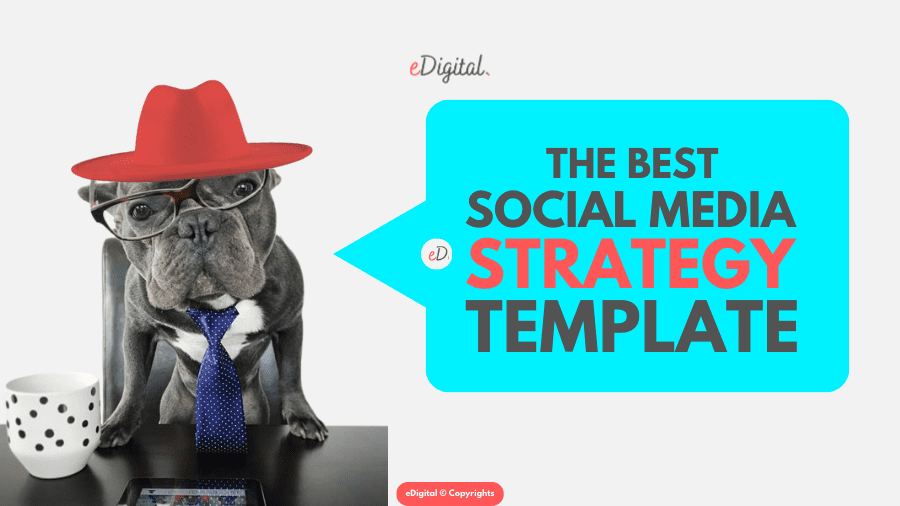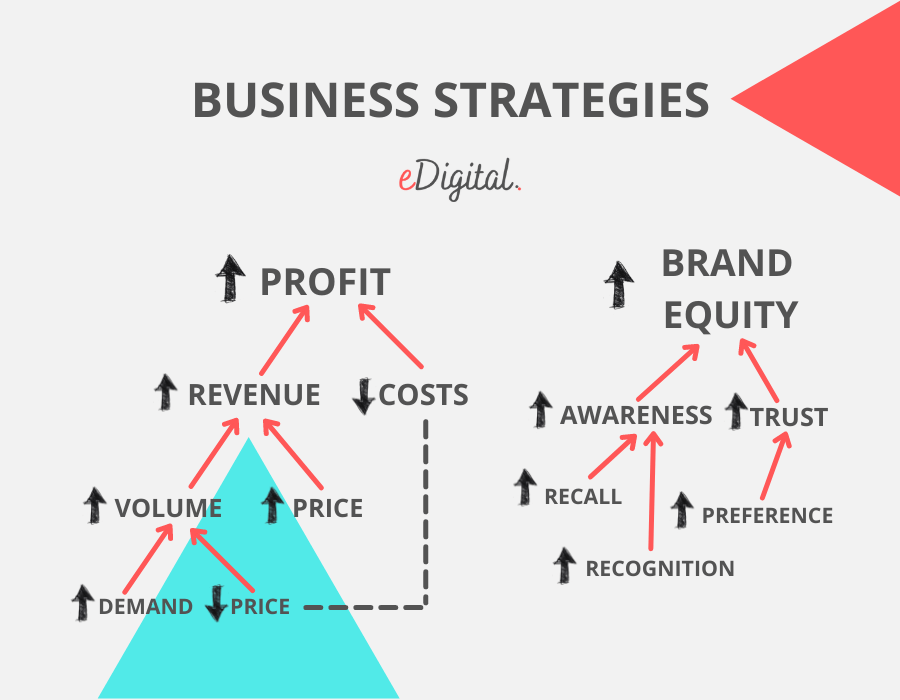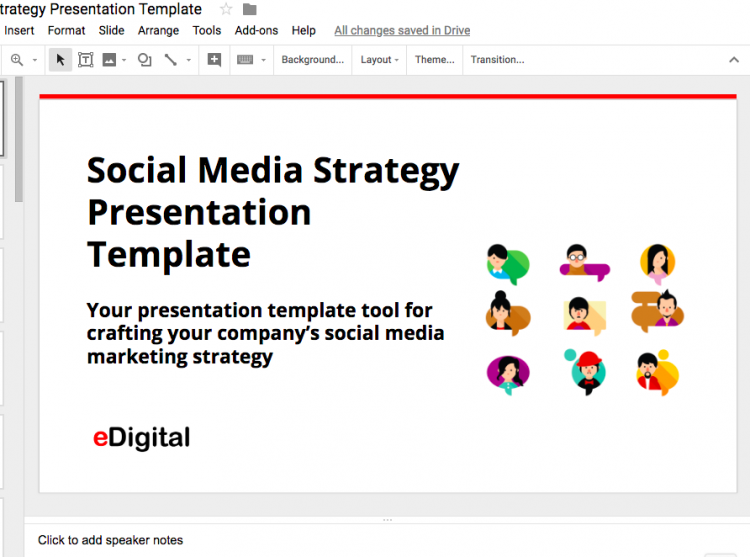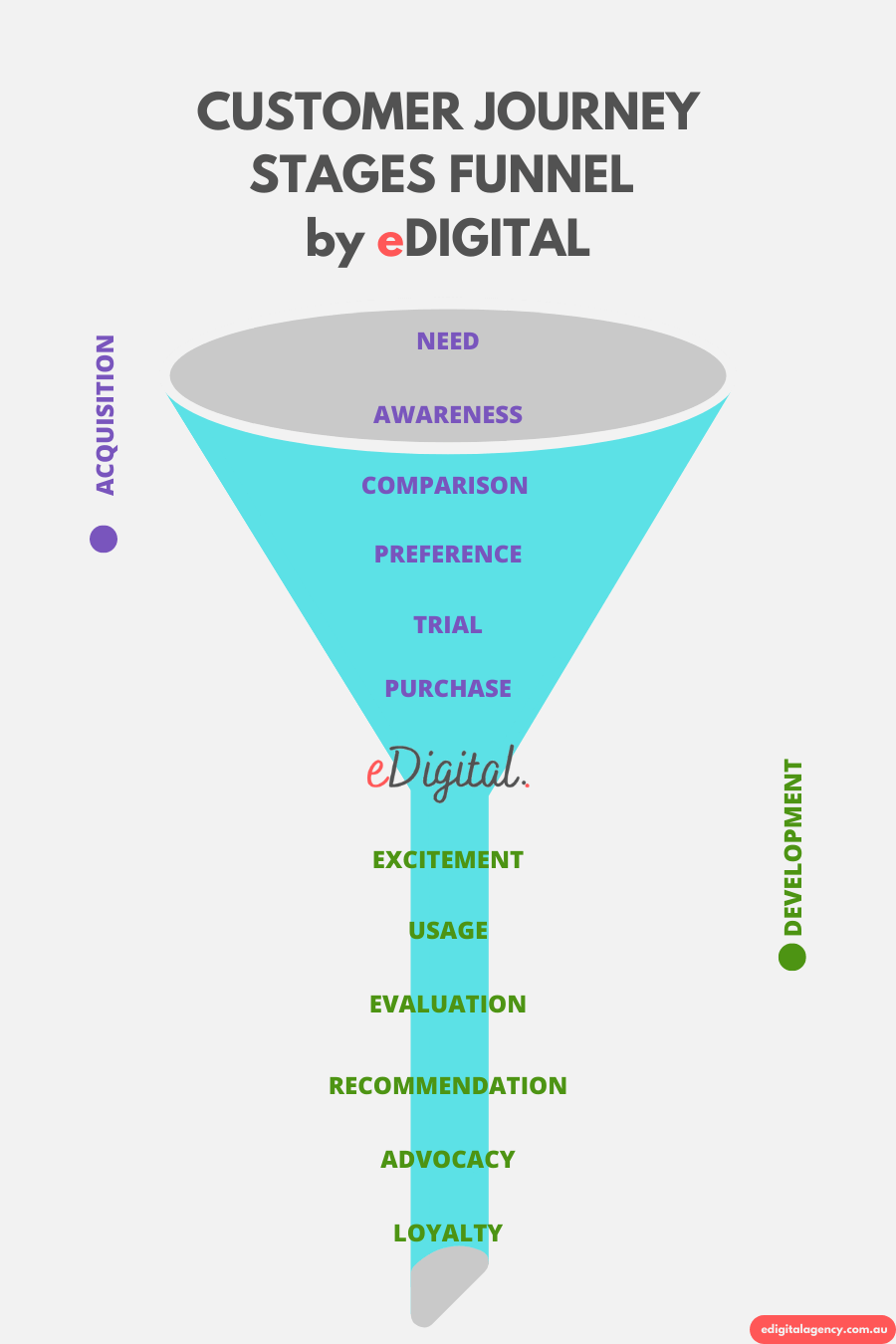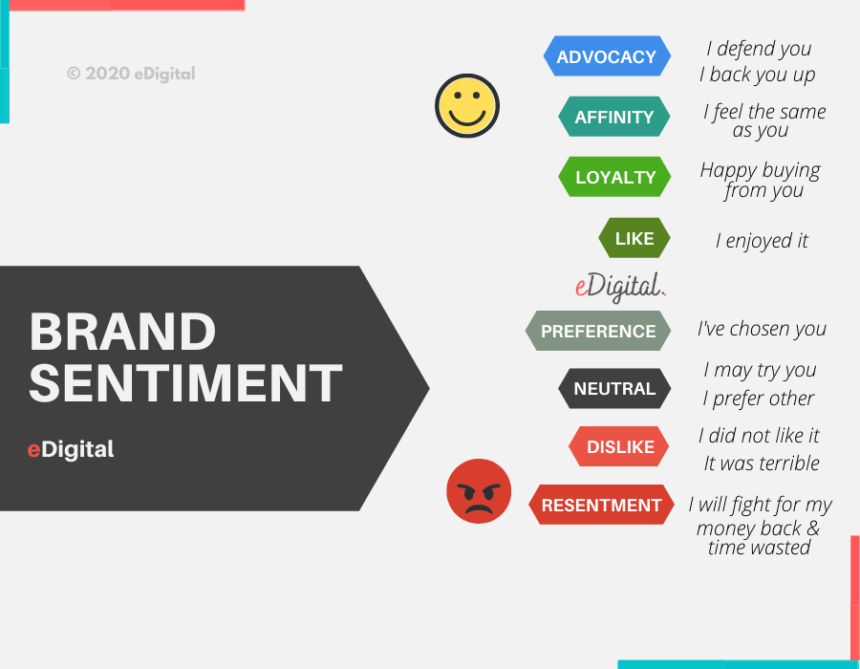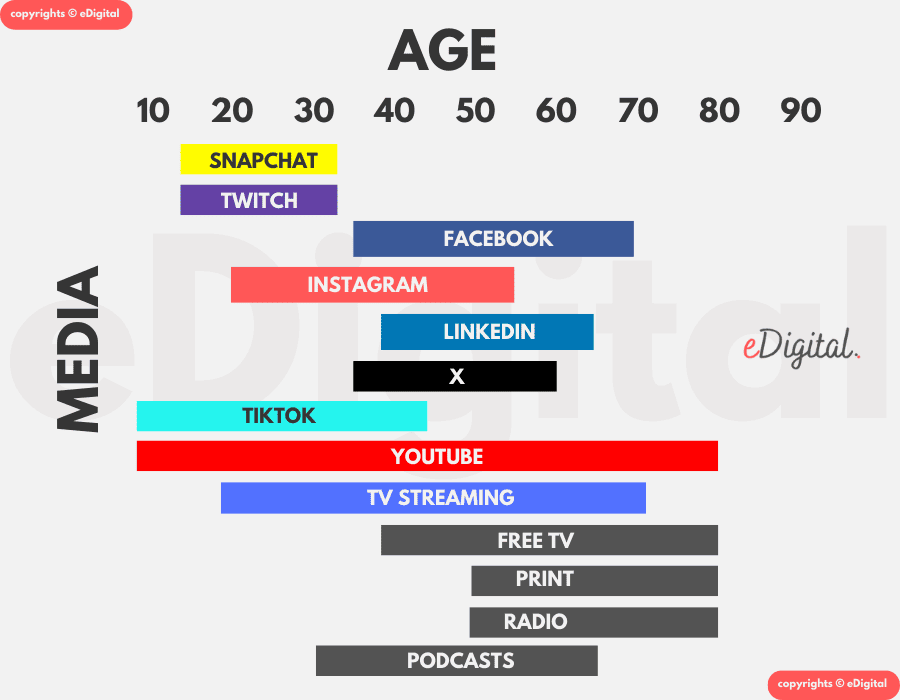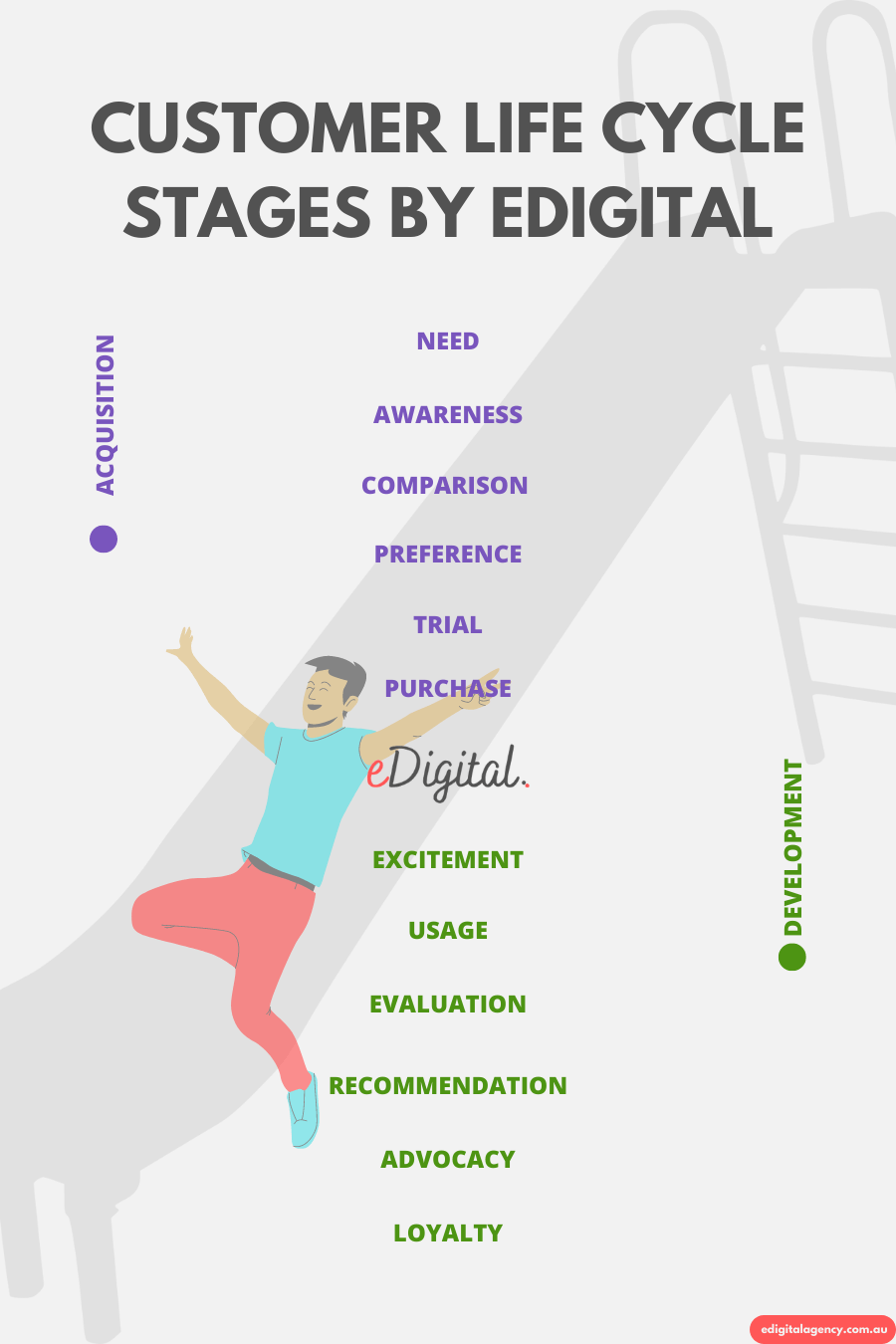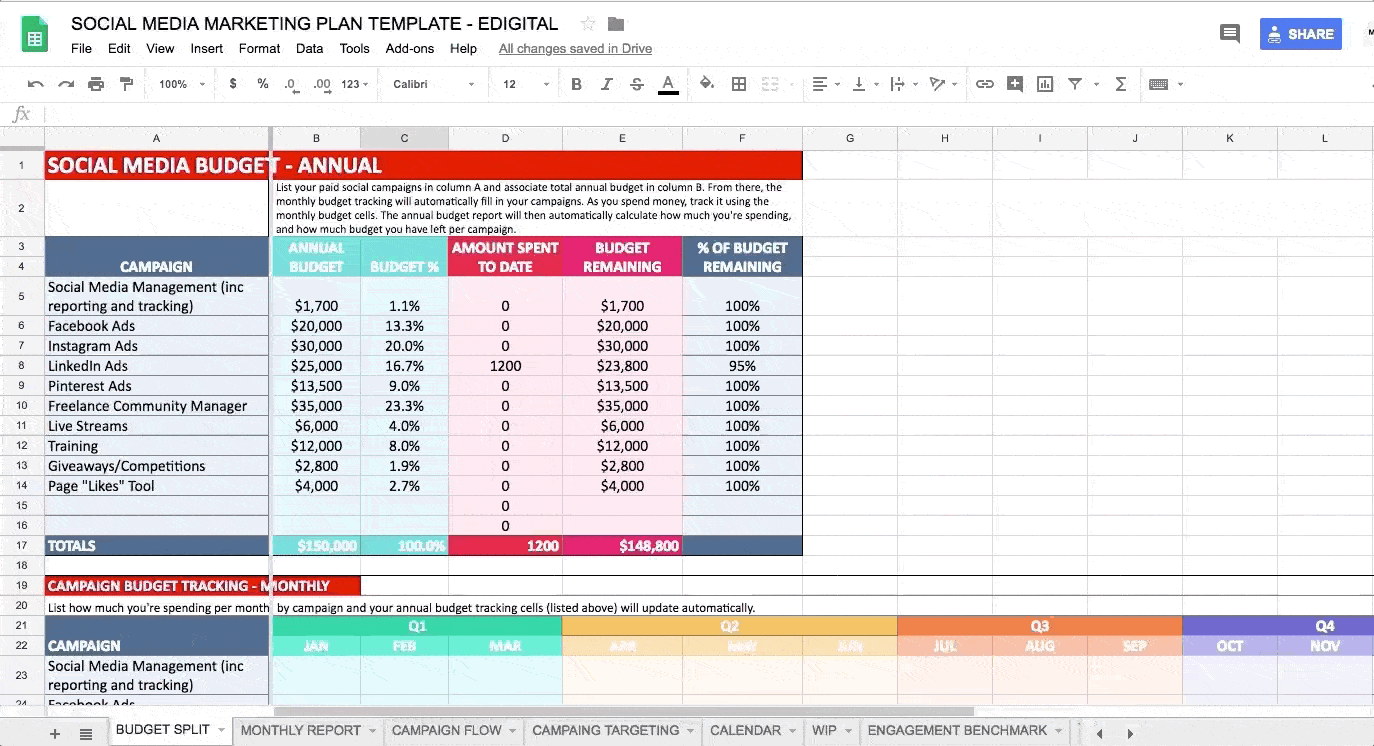THE BEST SOCIAL MEDIA STRATEGY TEMPLATE IN 2025
The best Social Media Marketing Strategy plan in 2025. A premium Social Media Strategy plan template on Google Sheets or use it as a Word document or PDF file.
How to write the best social media strategy for your business including and top tips and tricks.
Brought to you by Mau, a Senior Social Media Strategist at eDigital.
Get this exclusive Social Media Marketing Strategy Plan Template used by thousands of professional marketers, top entrepreneurs and savvy business owners to increase leads, sales, profits and brand equity.
This premium Social Media Strategy Plan Template is ready for real-time collaboration on Google Sheets.
You can also use it as an Excel, Word or PDF file.
How to craft a successful social media marketing strategy plan
Have you been asked to present a social media strategy report at your next team meeting and are not sure where to start? or are you an entrepreneur who needs clarity on where to focus your limited marketing budget, resources and time on social media?
This exclusive Social Media Strategy template handles what you do not have time for and you get instant access to the core taxonomy of a successful social media strategy plan with no need for guessing how to structure it.
The below best social media marketing practices, top tips and a premium template will help you boost the results you get from a well-crafted social media strategy. It will clearly show you what to plan and include to get the results you want from your social media marketing efforts.
Before you read the below top tips and template, you are about to understand what social media marketing strategy really is…
What does social media strategy really mean?
A Social Media Strategy should be a plan of action designed to help you achieve your top strategic marketing objectives.
A winning social media marketing strategy should specify the key objectives of social media marketing promotion and set the parameters for:
- Why is your business investing in social media marketing (describe the reason)?
- What should activities completed on social media deliver (goals and objectives)?
- How will the plan be delivered (actions)?
- Where will social media executions take place? In other words, describe how you decided on the selection of your social media platforms.
- When should your social media executions be delivered? This includes: timings and frequency, seasonality adjustments, etc (may include the selection of of the best social media scheduling tools)
- What tools, training and resources are required?
- Who will be responsible for measuring, auditing, managing, executing, optimising, reporting and presenting the results (stakeholders involved)?
- How much is the cost of your social media strategy (Budget)?
- What are the expected results and/or return on investment?
Importance of a well-planned social media strategy
Marketers want to establish deeper and personalised connections while consumers are using social media more heavily than in previous years. This increased focus speaks to both fragmented media consumption and the significant reach you can get across popular social media platforms such as TikTok, Facebook, YouTube or Instagram.
However, most social media platforms are not offering the organic reach they used to offer to marketers in the past. “If you do not pay, you do not play” has become a common quote in the social media marketing industry.
This means your strategy needs to find solutions to the low level of organic reach offered by the most popular social media platforms.
As increases in social media marketing budgets are predicted, greater importance is also now placed on optimising these budgets.
You know your social media strategy is working when you can demonstrate (with data) that every dollar you spend on social media is either increasing your sales or building brand equity. Because these are the main objectives of any business.
That’s why many professional marketers who are serious about making sure their social media marketing works for their businesses are consistently using our premium template.
About this premium social media strategy plan template
This is an exclusive & premium report template you won’t find anywhere else. It is ready on Google Sheets for real-time collaboration or you can also use it as a Microsoft Excel, Word document or PDF file.
Rack up the benefits of this template:
- Instant access. Do not wait for anything. Once you pay, you will be redirected to a confirmation page with the link to the template.
- Secure. Once you access this premium template, you can save a copy in seconds or keep it on your Google Sheets account. No one else will have access to it unless you permit them.
- 100% guaranteed delivery. You can always contact us if there is an issue.
- Fast support. Same-day response to any questions.
- Access your template anywhere/anytime. Just need an internet connection.
- Real-time interactive collaboration. You can grant permission to edit your document to other team members and see changes and/or updates in real-time.
- A universe of add-ons/plugins is available. Bring and manipulate data from your marketing department into your brief document using powerful plugins and add-ons available only on Google Sheets.
- Turn data into powerful charts. Use the Google Sheets editor to create and customise charts, if needed.
- Voice typing. Lazy to type? Use Google Sheets voice recognition to fill in your template.
- Perpetual access. Save the link to the template to always access the latest version of this template anytime.
Do not miss your deadline and present your social media strategy with this premium template today!
This professionally crafted template has been used by top marketers already using some of the best CRM software.
Template sections
- Strategy and Branding section
- Budget split tables with pre-made formulas
- Monthly report section
- Popular World holidays & events’ calendar with #hashtags
- Campaign flow & targeting sections
- Interactive UTM tracking builder
- Competitors’ engagement benchmark section.
- Event calendar section
- Social Media Posting Log section
- Calendar section to list your live streams
- Activation ideas log section
- WIP section
- Social Media Management Software Request for Proposal (RFP) section
When purchasing your Social Media Marketing Plan template, you will also receive:
+ Social Media Strategy Presentation Template – On Google Slides ready for cross-team collaboration, you can also save it as a Microsoft PowerPoint presentation.
+ “The best 4 Charts every social media manager should use” – Guide. Visualise your social media data with the best charts proven to help marketers present their results to their teams.
- Slope chart for growth of followers/ reach
- Maps for global/ regional engagement
- Scatter plot for reach vs. engagement
- Boxplots to compare distribution by categories
+ “Brand Voice Guidelines“. Keep all your content creators on the same page with well-documented brand voice guidelines.
The top benefits of a well-structured social media strategy plan
- Increase customer lifetime value. As consumers spend more time on social media channels, it has become evident marketers are using social media to increase purchase frequency and basket value which then increases customer lifetime value.
- Increase sales. Social media participation allows brands to increase the level of trust and preference from customers. Social media then becomes a critical touchpoint along the path of purchase.
- Generate better quality and greater results from providers. By sharing your social media strategy with key providers (marketing and PR agencies) the more likely they will produce work that hits your goals and objectives.
- Get buy-in. Presenting a professionally crafted Social Media Strategy allows other key stakeholders (CEO, others) to support your progress.
- Keep consistent. A clear Social Media Strategy will ensure all parties involved understand the why, how, who, when and how often your social media activities will be delivered.
- Choose what to monitor. Having a professionally drafted social media strategy will make it easier to choose what to monitor and revise and pivot your strategy accordingly.
Tip: You can keep it as a Google Sheets document for real-time collaboration or you can also use it as a Microsoft Excel or Word document or save it as a PDF.
Social media marketing strategy – Key considerations
Before you write a Social Media Strategy, you should have already defined your Marketing Strategy (concepts such as brand positioning statement, brand mission, brand vision and brand values).
Before you start, make sure you have ready:
- Value Proposition. Your social media strategy should follow the customer value proposition defined in your marketing strategy.
- Key messages. Also, your marketing strategy should have already defined your key messaging. Your social media strategy should feed on that and adjust the tone and voice for each social media channel.
- Audiences. Are you using different social media platforms to reach different customer demographics and psychographics? If so, make sure you document this on your social media strategy.
- Goals. When completing your Social Media Strategy Plan, you should write your top 3 social media marketing goals and how you are going to reach them. You must define a baseline and ways of correctly tracking your progress.
Tip: This premium template will help you set realistic and measurable objectives.
- It should not be a stand-alone strategy. Your social media strategy should sync with your offline, event and other marketing activities.
- Summary. Make sure you provide a summary of your strategy for stakeholders who have no time to read the whole strategy document.
- Stakeholder involvement is key. Invite other team members to offer input on your strategy. This may include other employees who deal with customers including sales and customer service/support teams.
- A defined agenda when presenting your strategy. If a set of meetings are required to define your digital marketing plan with different stakeholders; ensure you have a structured agenda and expected outcomes so the plan is agreed /approved.
The top 3 tips before you craft your social media marketing strategy
- Ensure your social media strategy is no longer than one year vision as social media changes so quickly.
- Make sure your social media strategy plan document can be accessed remotely and allows for real-time collaboration between different stakeholders (brand managers, copywriters, digital marketing managers, social media managers, agency teams, etc.)
- Your social media strategy should be concise and provide the governing principles and steps that guide the plan.
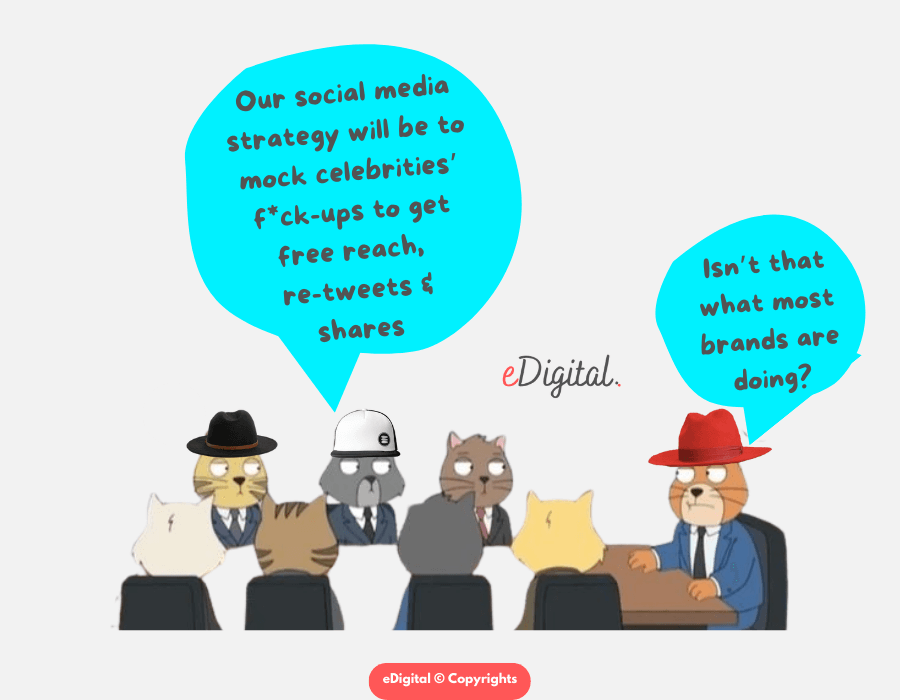
Social media strategy celebrity funny meme. Ridiculing celebrities has become one of the top ethical issues in Marketing.
Writing a winning social media marketing strategy – Steps
Below are the most important steps when drafting your social media strategy. These steps will help you collect key information and insights and present your plan insights for key areas including:
Strategy statement
Your strategy statement should be a short, concise summary of what your social media strategy is aiming to achieve, broken down into bullet points.
Below is an example from a client we worked with:
- We are investing in social media marketing because our most valuable customer segments are not only using social media when comparing, finding new products and making purchase decisions about our category but also they are expecting us to offer them information – via social media – that helps them better use our products.
- We will start with a full social media audit, benchmarking current results against our top 3 competitors and implementing key improvements identified.
- The foundation of our social media strategy will be promoting: the content generated by our users with our products, our “ever-green” content pieces, seasonal campaign stories and promotions. We recognise that we will need to allocate some budget $$ for boosted posts to achieve our reach and engagement objectives.
- A key part of our Social Media Marketing Strategy will be to participate (comment or partner) in other key social media accounts, forums and social media places where our current and potential customers hang out.
- We will allocate 10% of our social media budget to respond to customer feedback, comments, questions and general enquiries published via social media channels.
- Increasing our engagement (likes, shares, comments) will be our focus to help aid purchases through organic & paid activity.
- We will use social media to shape sentiment in all our different types of customers: potential and current customers, best customers in our loyalty program (frequent buyers), advocates, influencers and detractors, critics and online bullies/attackers.
⭐️⭐️⭐️⭐️⭐️ What we need it
This template allowed us to see what was working in our social media (and how to do more of it) and identified the time-consuming and money-wasting tasks that weren’t helping our bottom line (which we have now stopped doing)
Mia B. ✅ Verified user
Goals and objectives
Goals define your high-level aims and objectives use SMART criteria to ensure each goal has a measurable set of criteria against which to evaluate progress. You can use SMART criteria for objectives because they encourage you to think about the practicality of achieving each goal, rather than focusing on things that sound good but might not be feasible.
S = Specific in terms of what needs to be achieved
M = Measurable so that progress can be tracked and evaluated
A = Achievable so that your team has a realistic chance of success
R = Relevant to your business so it’s aligned with overall business goals
T = The timeframe within which the objective must be satisfied
High-level goal examples:
- Complete social media audit and implement actions arising from it
- Create and keep updating a three-month social media content calendar
- Begin regular social media activity, in line with strategy and calendar
- Create and work within a measurement framework
- Demonstrate the impact and ROI of social media to the wider stakeholders of the business.
An objective example using the SMART formula:
Increase 50% (Measurable) the number of people visiting our product pages from social media channels (Specific- Achievable -Relevant) compared to last financial year (Time-based).
Below is our eDigital “Customer Buying Cycle” graph you could use for your customer journey mapping, making sure your social media content aids every single phase of the customer journey.
Strategic challenges
Here you set out the business challenges for successful social media marketing that need to be overcome by your team and the strategic actions and activities that will enable them.
Example:
Strategic Challenge 1: Limited understanding of new social media platforms playing a growing role in our industry: TikTok, Snapchat, and Instagram. Strategic Response 1: We will evaluate it as part of our social media audit and invest in training and design guidelines for usage when appropriate.
Target audience
This section will define who exactly you want to reach and engage with on social media platforms.
You will define your core audience (personas, profiles, demographics etc.) and identify any new customer types that you want to attract based on your products/services.
Find below some target audience examples:
Loyal customers
Regular customers who are either on our Loyalty Program or are already connected to our social media channels.
Goal: Get them to buy more quantity | Increase purchase frequency | Move them to buy premium products | Reward them for their recommendation
Key Social Media content: We will use special offers, educational demo videos for premium products and a $50 voucher for every person who has signed up for their recommendations.
Brand switchers
Customers who have bought your products but aren’t regular shoppers and haven’t connected on social media.
Goal: Get them to re-purchase our products.
Key Social Media Content: Special offers, promotions and invitations to key activation events
Potential customers
People who have visited but have not purchased from us.
Goal: Get them to find our content and incentive them to participate in our events and subscribe to our e-newsletter
Key Social Media Content: activation events, influencer content, special seasonal deals and promotions.
Influencers
Customers with a following base higher than 10,000 followers per channel who are using our products.
Goal: Offer them a complementary product in exchange for an agreed set of posts.
Key Social Media Content: we will let them create their own content with our products.
Detractors / Trolls/ Attackers
Anyone who creates bad publicity about our company
Goal: Respond and take conversations offline when appropriate.
Key Social Media Content: we will use the “XYZ” social media listening tool to find this content to respond in a timely manner.
You can use brand sentiment surveys, research and analysis to find out what the overall sentiment is for each customer segment you are targeting. The successful executions of your professional social media strategy will help you change the customer segment’s sentiment towards loyalty, affinity and ultimately advocacy.
Channels
Here you will spell out what you’ll be doing for each social network to satisfy the goals of your social strategy. Include a brief description of any related process, people and tools.
Tip: Age is an important demographic consideration when choosing your media channels as per our graph below.
Example:
“We will use our primary Facebook handle as both a customer service channel and a broadcast/interaction. Facebook will be used to make our customers feel extremely accessible to us. This will be beneficial in developing brand engagement. Key actions:
-
- Following key influencers and thanking new followers personally (and doing this regularly)
- Posting at least one time a day (using a tool like Buffer to help schedule updates)
- Sharing interesting and inspirational posts from other Facebook accounts.
- Sharing every blog post (in case you missed it)
- Highlight customer service success stories at least 2 times a week.
- Handling negative commentary to demonstrate that we take issues seriously and move the conversation offline when appropriate
- Being innovative with Facebook post formats e.g. testing Q&As with your product experts on specific topics
- Facebook carousel image ads will be trialled around product launches or specific campaign pushes”
The latest version of this premium template has just been released. Don’t miss your deadline for presenting your plan and securing your social media marketing strategy template today!
Integration of social media with other marketing executions
This section is to describe how social will align with some of the best marketing channels so that the people doing the work understand the wider picture.
Example (email marketing):
- We will use our social media platforms to promote our newsletter content
- We will promote email sign-up as part of our social media content calendar with specific offers.
- We will feature popular social content in relevant e-newsletter emails.
- Our social network links will be included in the email footer
- Emails will include a social sharing option
Measurement
The last phase during the execution of your Social Media Marketing Plan is to ensure you are measuring progress and have your success metrics ready to be compared with your initial baseline.
How to measure social media
-
- Start by defining the KPIs for your social strategy.
- Define macro KPIs, for example: increase website traffic from social media.
- Define micro KPIs (channel specific e.g. increase the number of comments on Facebook).
- Align your KPI expectations with the metrics that you can track for each social network so that they can easily be measured.
- Check that your web and social media analytics tools are configured correctly to capture all relevant data.
- Include details of the reporting you’ll do to measure performance, and where these reports can be accessed.
Review process
This section will allow for your Social Media Strategy to be flexible to respond to changing market conditions. You should include an explanation of the Social Media Strategy review process:
- Who will lead the review (business sponsor)?
- How often will the review take place?
- What data/insights will be used to inform the review?
- What will the outputs be?
- How will outputs be measured/monitored?
Some marketers include a “Social media policy/guidelines” document in the strategy but we don’t think this is the best approach. Guidelines are part of the tactical execution, providing a set of rules for the business to adhere to. It’s not a strategic activity, so this content sits best within the tactical plan, or as a separate document referenced by the plan.
Related documents
This section is for you to include the links to all other documents that are relevant to your social media strategy so that anyone in your team or agency support can find them and get the full picture.
- Branding and positioning section. Before you start your social media activation, it is critical your social media team and partners understand your brand. In this section, you will write down key information about your brand including what issues/problems the brand is trying to solve. Unique elements brought to market: product features, range, delivery, customer service, rewards, program, convenience and cost-saving. It will also ask you to define your brand mission, vision, values, language and design.
- Campaign flow section. In this section, you will map out all the social media activities to reach every single customer touchpoint within the customer life cycle. This includes category need, brand awareness, brand consideration, brand preference, trial, purchase, excitement, usage, evaluation/review, recommendation, advocacy and loyalty.
- Social media calendar section. This is a stand-alone section of your plan and should define all tactical social media activities your audiences will see, read and listen to. Your social media calendar should allow you to easily see what has been scheduled to be published on each social media platform. We suggest keeping this tactical calendar only three months in advance as things change so quickly.
- Monthly report section. You will access pre-built tables to present your monthly social media results by owned media and earned media. There are specific columns for % change compared with the previous month and the same month last year.
- Work in Progress (WIP) section. When working with a different team and on multiple projects, it is important to have a list of key social media activities/tasks you and your teams need to track and ensure they get completed. Here you can also track all the key deliverables you confirmed on your initial strategy. This can include things such as social media audit, social media platform selection strategy, measurement framework, evaluation report, etc.
- Budget section. This area is to have an accurate picture of how you are spending your social media budget. It should be a no-brainer.
- Campaign tracking section. We recommend using campaign tracking parameters (commonly called: UTM parameters) in all URLs you promote or share via social media. This means adding UTM parameters for at least medium, source and campaign. Using UTM parameters will help you drill down into traffic from social and isolate specific elements of activity, such as individual links. You can use this for differentiating between different content formats, such as text vs. image vs. video updates for the same campaign. You can overlay e-commerce goals and/or conversion data to see what specific social media post(s) are helping you reach your specific social media marketing goals and use the learning to fine-tune your social media strategy.
- Engagement benchmark section. The template shows an example of how to do a Social Media benchmark for Instagram. So you can compare your engagement levels against competitors.
- Post log section. This is a great section to get your social media assistant to complete so all her social media posts and destination URLs are organised and logged in one single sheet.
- Live stream calendar section. Social Media Live Streams require far more preparation than your usual social media posting. Therefore, this section allows you to add your future live streams including your live stream details: Campaign name, live stream title, speakers, date and time and filming location.
- Activation ideas log section. Log all your stakeholder’s activation ideas ready to be reviewed and prioritised by your team.
- Social media management request for proposal section. This section is really useful for enterprise-level marketers who are looking to review a new social media management tool in the near future. You will have access to the best questions you should be asking your potential social media management vendor.
- Yearly event calendar section. You will have access to more than 200 yearly international and national events organised by month so you can easily match what’s trending with your social media activity.
- Gantt Chart template. Most social media managers at some point will have to organise an event. This might be a product launch inviting influencers, a conference inviting industry leaders, an awards night, etc. For this reason, we have created one of the best event planning templates within your Master Social Media Strategy template so you can start planning your event at any time 🙂
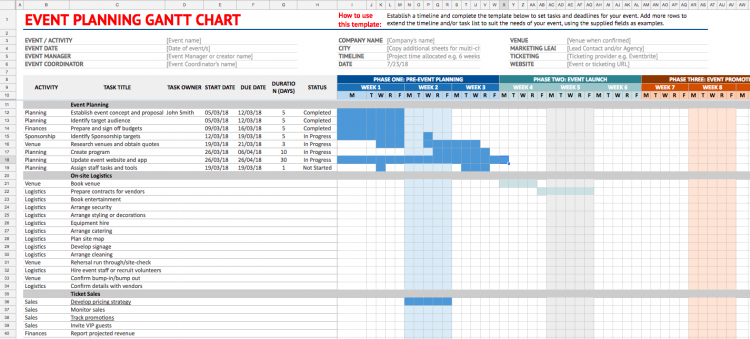
best event planning Gantt chart template
⭐️⭐️⭐️⭐️⭐️ Clarified our goals
This template got my entire team going in the same direction with enthusiasm and commitment to reaching our social media strategic goals and understanding what we are trying to accomplish.
Belinda L. ✅ Verified user
Benefits of this premium social media strategy template
- Saves time! Yes, you could start a template from scratch but why? Request this template and you will be working with your colleagues on it straight away! We have invested some good hours making sure it is nicely presented and the formulas on some of the worksheets have been tested and work great. The benefit of having it on Google SpreadSheet is that you can give access to your social media and/or marketing team wherever they are as the document will live on the cloud. They can also add comments to any cell and people will be notified when commenting is happening, making it a dynamic template 🙂
- Helps you plan tangible executions for your customer journey! This template will help you identify and plan key social media activities and develop a strategy to make your business stand out in social media, increase customer awareness of your product and services, increase preference and trial and ultimately drive people to buy (purchase), increase repeat purchases and loyalty and advocacy.
- Helps you keep track of your social media objectives, budget and activities. It has been carefully designed to help you easily present and track your marketing objectives, strategies, budget and tactical executions.
Below is an example of the Budget Split section…
- Get buy-in from other stakeholders. One of the most challenging parts of social media is to show ROI to your management team. This template allows you not only to get buy-in from your executive team but also allows them to have access if they wish as you can save it as a collaborative Google Sheet. You can handpick the stakeholders to have access to it.
Get this Social Media Marketing Plan template today!
Get the latest version of this premium template that has just been released. Don’t miss your deadline for presenting your plan and securing your Social media marketing strategy template today!
How to get this premium social media strategy template
Steps:
- Complete payment on Paypal.
- Once payment is completed, choose “Go back to merchant” to be redirected to a confirmation page where you can find the link to the template on Google Sheets.
- Any issues, you can always contact us. We respond in less than 8 hours.
You will also get:
✅ Social media management software request for proposal. The top 50 questions you must ask your potential social media management software provider. Choosing a social media management solution can be tough, especially for larger organisations. That’s why the social media experts at eDigital rounded up over 50 popular questions to include in your Social Media Management Software Request for Proposal. The sections are broken out by different solution functionality, and you can delete any item that isn’t a need for your organisation. You can also add lines for functionality not listed. Once you have decided what features and solutions your team needs, brand this document and send it to providers. If you have your own RFP template, just pull out all of the questions you thought were important and add them to your own document.
✅ Hashtag holiday calendar. Whether you’re raising awareness for World Mental Health Day or celebrating your inner foodie with National French Fry Day, there’s a national holiday to associate your brand with. Professional marketers like you rely on holidays to get people to engage, share content, promote a cause or celebrate. However, with the vast number of holidays celebrated across the globe, it may be a challenge to gather the right and most used hashtags for each holiday or celebration. On this premium template, you will have access to the most popular global events, holidays and celebrations with their corresponding hashtags. eDigital has cherry-picked a combination of both generally celebrated and industry-specific hashtag holidays and compiled them into this exclusive social media marketing plan template for you.
The 3 essential tweaks to improve your social media strategy
- Customer profiling tweak. Is your current social media strategy really taking care of your most profitable customer segment? Your most profitable customer segment tends to be that 20% of customers bring 80% or more of your revenue. How is your social media inspiring them to buy more quantity, more often, more premium or bring more of their friends?
- Content tweak. Are you only sharing info that talks about you and your products/services? and engagement rates are low? You might want to try re-sharing real authentic customer stories using your products or services. We at eDigital, for example, have found success publishing micro-niche “ever-green” content that solves specific digital marketing issues. Some of this content that does not necessarily sell any of our services is part of our top 20 most visited pages on our site. The benefit is that we believe is that as long as we are helping a marketer solve an issue is worth the investment, even if that means it is not a direct sale.
- Channel time investment tweak. For some reason, your CEO says you need to be on all social media platforms so you go and open accounts in all of them to realise you do not really have the time it needs to really build an audience on each platform. With limited time, budget and human resources helping you with your social media strategy you will need to choose your top 1-2 platforms where you believe your most valuable customer segment is more open to hearing from you. Do not be afraid to deactivate a social media platform (keep the account just in case) if that means you will have more time to post, respond and participate and build deeper relations on a specific platform. If you need advice on how to present the case to your CEO, please contact us.
The 5 key elements for cracking the social media strategy code
- Use last year’s data to inform this year’s strategy. Dive into last year’s social media analytics and figure out what worked and what fell flat. Look at the success (or failure) of the social media campaigns you launched, the activity and engagement on all of your platforms, and what type of content resonated with your audience the most. You can do this by conducting a social media audit. An audit keeps your finger on the pulse of your social media strategy to see what’s working and what’s not. Based on the previous year’s data reports, you might want to switch up the time of day you post, in order to reach more of your target audience and drum up more engagement. Or, you might want to focus on Facebook over Instagram because you’ve seen a more consistent return on investment (ROI) on one platform versus the other.
- Review the top social media trends. Social moves quickly so it makes sense that you’d want to incorporate—or at least consider—the top social media trends. Assess them against your business goals to determine if any of them are right for your brand’s strategy.
- Craft your brand’s visual story consistently. Does it feel like your social media profiles are from different businesses? If so, get this fixed immediately! This is the most important component of the social media strategy. You must define your visual branding, voice and tone. Are your messages conveying “value” to your most valuable customer segments? Keep an eye on what your competitors are communicating and be alert to approach opportunities.
- Use growth hacking tactics. What automated growth marketing software are you using that is helping you build your social media audiences? Contact us if you need professional advice in this regard.
- Make the plan visible. It’s both – one of the biggest challenges and the greatest privileges – a social media manager’s work is so visible in an organisation. To ensure there are no surprises – and mitigate negative feedback after posting- make sure there is cross-functional integrated planning to give your wider team visibility to your plan and its content.
⭐️⭐️⭐️⭐️⭐️ Brought structure and clarity to our efforts
The template helped us set priorities for social media marketing efforts in a systemised way so we are no longer guessing or hoping for good results – they were planned with this template.
Oli W. ✅ Verified user
The 5 “early warning” signals for a social media strategy revamp
- Treating social media as business as usual. Promoting your services via social media requires creativity, reinvention and breaking rules. Because there are no gatekeepers, people are constantly pushing the limits and demanding more realness and honesty. Businesses that treat social media as just another mass marketing channel will fail.
- Your highly curated visuals are not getting “likes”. Website visitors and social media users want to see visuals portraying real people enjoying products and/or services. Having the “style perfect” photo is not enough. You will need to dedicate more time to listening and tracking your customers’ content and pinpointing what’s relevant to share with your community.
- You run social media ads but no one is following up. Have you noticed companies that run social media ads but when you comment on these paid (boosted) posts there is no one responding? In this scenario, you will need to accommodate some social media budget into someone in your team who can respond to customers’ commentary.
- Only publish social media posts about your product and services. Making people aware of your products and services is just one part of the customer purchase journey/funnel. Your social media strategy should also help your brand tap into the other key elements of your customer purchase journey.
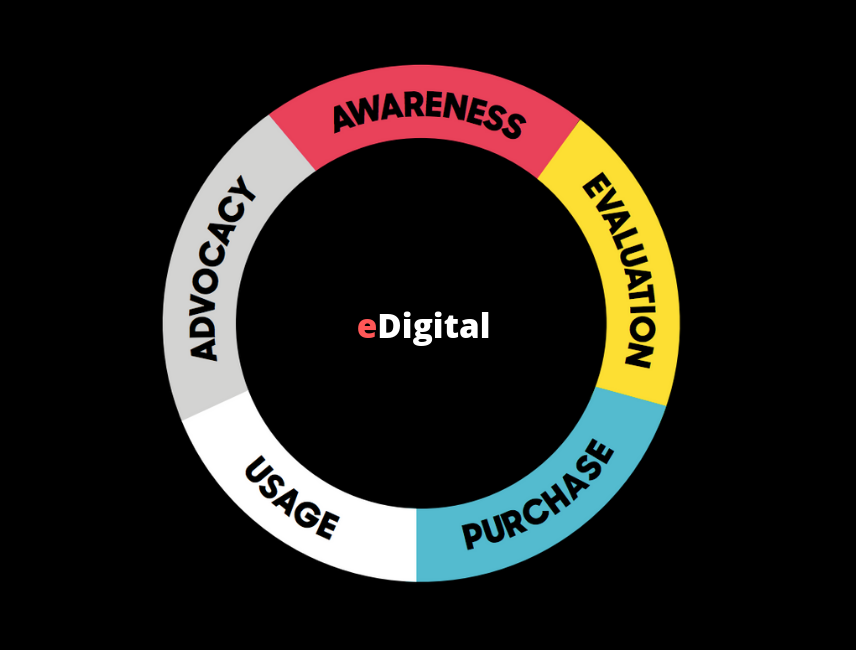
customer purchase journey cycle eDigital
- The CEO does not really care about social media efforts. this can be common if your CEO is a baby boomer and did not grow up using social media. You need to ensure your social media objectives and linked to the overall marketing and sales objectives. This way any progress you make, can be reflected in the overall sales and marketing targets your CEO should easily understand.
Make your sales team social sellers. Immediately!
The latest LinkedIn “State of Sales Report” surveyed 2,000 B2B professionals about how they perceive technology is impacting sales. The top takeaways were:
- The majority of people consider social media important for closing deals!
- Social media should be about building your sales team as “trusted advisors”.
- Cold phone calls are less effective.
So, how can your sales team use their social tools to bring quality leads, nurture them and win new deals?
- Social media should be your sales team’s “go-to destination” for learning about potential customers. Your sales team can get “valuable insights” about prospective customers from social media. Potential customers won’t engage with people who don’t understand their business. That’s where “e-stalking” comes in handy. Look closely at the other person’s social media profiles, especially Linkedin to see how they describe themselves. Note how they talk about their roles, past and present. Comb through their skills and endorsements to see what technologies they regularly use. Elsewhere, note what they tweet about, who they follow, and if they share information on smaller, industry-specific social networks.
- Customers prefer to work with salespeople who are active on social media. Buyers of your services or products might also be looking for “an informative LinkedIn profile about your sales rep” before they consider talking with anyone in your sales team. Your sales team’s social profiles are hugely important in helping them achieve their sales targets.
- Get a hand helping them improve their social media profiles. There are always opportunities to improve their social media profiles. For example, your sales team should pack their LinkedIn job history with interesting details and accomplishments, and use the summary section to add interesting details about your sales rep role that should be useful for your potential clients. Do not limit yourself to Linkedin but also check other social media platforms where potential customers might go to look for your sales team profiles. These might include Instagram, Facebook or specific industry networks. A few appropriate personal details can humanise their profiles. For example, I like to share some of my hobbies: trekking, travel, philosophy, dancing and football, making it even easier for someone to approach me. No surprise I have clients interested in similar topics.
- Buyers care more about trust than price. This is one of the most important aspects your social media strategy should help you build: Trust. Potential Buyers need to feel they can trust your sales team reps. Social media is a great way to build transparency and transparency builds trust. Your sales team should send “transparency” signals that potential buyers can trust them and see them as “trusted advisors”. Transparency signals can include approximate costs and profit margins they make, quality and sourced providers, trial periods, certifications and industry rewards. According to the 2017 LinkedIn State of Sales Report “trust ” is the most important factor when choosing a new provider, 3 times more important than the second in the list: price.
- Buyers will contact a sales rep they remember – likely from social media content and/or e-newsletters your sales rep has shared –. Even if your sales team is sending emails with fantastic information and some potential customers do not open these emails, it is okay. We all have super busy schedules and most of the time we cannot read great info that hits our inboxes, that does not mean we are not interested, simply it is not a top priority. The great thing about social media combined with email follow-ups is that when a potential buyer is looking for products or services you offer, he will be more likely to contact the ones he remembers – likely from interesting social media posts and e-newsletters.
Social media strategy for a product launch
Social media platforms have brought consumers closer to their favourite brands than ever before, and many people follow their favourite brands to stay up to date with the latest product launches.
Apple, for example, turns to YouTube to announce the newest iPhone model. In 2019, Apple live-streamed the product reveal for the public for the first time, drawing nearly two million viewers.
Social media surely has become one of the most popular marketing channels for brands to launch new products: you can offer real-time updates to your customers and fans and consumers can provide brands with direct feedback about their initial impressions.
Next: Get immediate access to this exclusive & premium template and start writing your social media strategy today!
Conclusion
A well-planned social media strategy will help you attract fans, build a positive brand reputation and increase leads and sales. Marketing teams with a social media strategy are more effective at increasing brand preference and organising and delivering promotional activities on social media platforms.
Final note: Are your marketing costs through the roof?
If your customer acquisition costs are climbing faster than a startup founder’s ego (after a successful IPO), and you’re hooked on paid ads like a reality TV star drama or a Tinder date who keeps accepting your dinner invites but never calls you back.
If that sounds like your situation, you should contact us.
Our exclusive digital marketing strategy workshops will mercilessly dissect your marketing, expose all the weak spots, and show you how to ditch the social media algorithms chokehold and build a marketing engine you actually own.
We’ll shake up your team’s thinking, drop fresh ideas and turn your marketing from “meh” to money-making.
Ready to stop burning cash and start making it? Hit us up! We offer:
🔥 Digital Marketing Strategy. Because hope is not a plan.
🔥 Online Ads (Google, Social, Remarketing). The art of spending money wisely for once.
🔥 Social Media Marketing Training. So you stop posting into the void.
🔥 SEO Strategy & Execution. Because if Google doesn’t know you exist, do you even?
🔥 Influencer & Celebrity Marketing. Get people with clout to talk about you.
🔥 Branding & Logo Design. So you don’t look like a dodgy side hustle.
🔥 Consumer Giveaways & Competitions. Because people will do anything for free stuff.
🔥 Email Marketing & Drip Sequences. Slide into inboxes the right way.
🔥 Conversion Rate Optimisation. Turn window shoppers into actual buyers.
THE BEST SOCIAL MEDIA STRATEGY TEMPLATE IN 2025
Considered one of the best marketing consultants in Sydney (and not just by Mau’s mom), Mau delivers killer digital marketing strategy workshops and best social media training so good, even your grandpa will get it.
5k+ smart marketers who love stealing good ideas receive Mau’s weekly email, while others tired of guessing use Mau’s Digital Marketing Plan and Social Media Plan templates.
Mau is travelling the 🌎 ✈️ probably posting questionable travel choices on TikTok or YouTube

